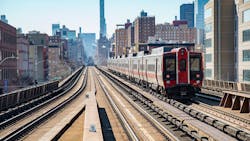Metro-North Railroad begins reconstruction work on 130-year-old Park Avenue Viaduct
Reconstruction work on the Metropolitan Transportation Authority’s (MTA) Metro-North Railroad 130-year-old Park Avenue Viaduct in East Harlem has begun, as areas underneath have been cleared for the viaduct's new foundations and columns that will support the new structure.
“Carrying hundreds of thousands of passengers every day, the Park Avenue Viaduct is a critical piece of our transportation infrastructure,” said New York Gov. Kathy Hochul. “This replacement is essential to providing faster and safer service to our Metro-North customers while minimizing impact to the local community.”
The Park Avenue Viaduct is an elevated steel structure that carries four Metro-North Railroad tracks along Park Avenue between East 110th St. and the Harlem River Lift Bridge. Metro-North Railroad trains traveling along the Harlem, Hudson and New Haven lines utilize the Park Avenue Viaduct to access Harlem-125th Street Station and Grand Central Terminal, totaling 98 percent of Metro-North trains.
“The Park Avenue Viaduct is a critical link between Grand Central Terminal and every city, town and village that Metro-North Railroad services in the Bronx, north of New York City and in Connecticut. Brilliant engineers and builders left a structure that has lasted for 130 years but we need to overhaul it to keep service safe for the 21st century,” said MTA Chair and CEO Janno Lieber.
“Park Avenue Viaduct infrastructure is well past its useful life and it’s time to build a more resilient viaduct that can serve the region for another hundred years. MTA C&D will utilize innovative modern tools and materials to reduce construction noise and vibrations to the surrounding neighborhoods and we are coordinating closely with the city of New York to integrate this project with New York City Department of Transportation’s street improvements,” said MTA Construction & Development (C&D) President Jamie Torres-Springer.
The $590 million for the first phase of the Park Avenue Viaduct Replacement project will replace major segments of the elevated steel structure, nearly half of which was first built in 1893, to ensure it remains in a state of good repair; $500.9 million is federally funded.
Phase 1 work will include replacing existing structures, tracks, power, communications and signal system from East 115th St. to East 123rd St. Phase 1 construction will continue through 2026. Work currently is underway for substructure construction, focusing on the viaduct’s foundations and columns.
The project seeks to minimize impacts on the surrounding community by strategically phasing the work, which also results in limited impacts to Metro-North train schedules. In line with community feedback and in conjunction with the State Historic Preservation Office, project design elements will include a more welcoming lighter color structure, improved lighting and increased pedestrian safety under the viaduct. By utilizing modern design standards and materials, the new structure is expected to reduce local noise and vibration levels as compared to existing levels.
MTA Arts & Design is also coordinating a permanent art installation for 116th St. as part of the project. The project builds on more than $24 million of recent MTA investment in the Harlem-125th St. Station area, including lighting improvements, station work performed under the enhanced station initiative, customer service kiosk enhancements, stairwell replacement and the painting of other sections of the viaduct.
As a part of the project, the MTA has entered into a Project Labor Agreement (PLA) with the Building and Construction Trades Council of Greater New York and Vicinity, its participating affiliated local unions, and their members. The agreement – representing the first PLA since the creation of MTA C&D in 2019 – is a commitment to working with union partners to improve labor efficiency and reduce costs on capital projects without compromising worker pay or safety. Cost savings are expected through improved work rules – such as unified holidays, 40-hour work weeks, flexible start times and maximum use of apprenticeships – as well as enabling health insurance reforms that provide better treatment of workplace injuries and reduce lost time.
“Every train Metro-North operates east of the Hudson River – 750 passenger trains a day – either travels over the Park Avenue Viaduct or connects with a train that does so to call this 130-year-old infrastructure ‘critical’ seems like an understatement. Metro-North is extremely appreciative MTA Construction & Development has prioritized replacement of the viaduct in a timely way that will allow the railroad to continue operations without significant disruption to schedules,” said MTA Metro-North Railroad President Catherine Rinaldi.
Project benefits
- Maintains public safety, makes the viaduct more resilient and ensures continued Metro-North service for the 98 percent of Metro-North trains reliant on the viaduct for service
- Reduced local noise and vibration levels through utilization of modern design standards and materials
- Increased pedestrian safety under the viaduct
- Permanent art installation at 116th St.
Project timeline
- Q3 2023: Construction activity underneath the viaduct (substructure construction) begins.
- Q2 2024: Construction on the viaduct (superstructure construction) begins.
- 2026: Phase 1 concludes
